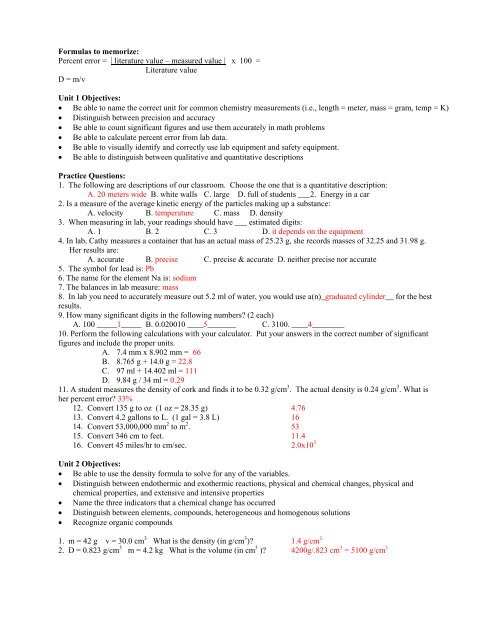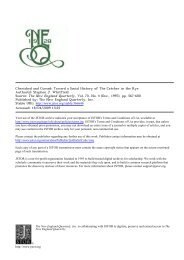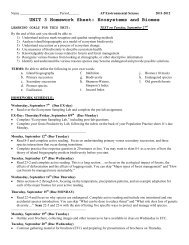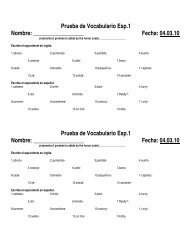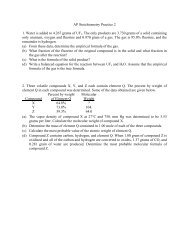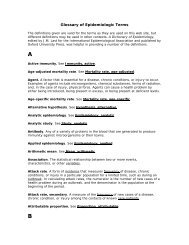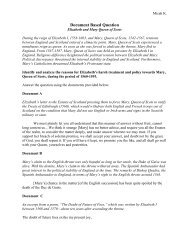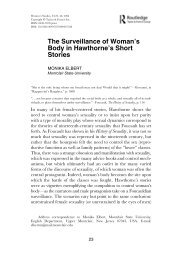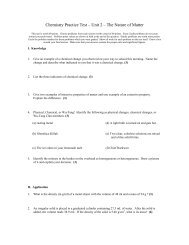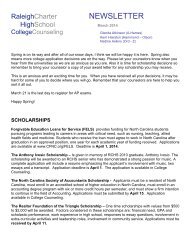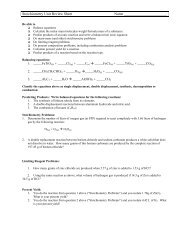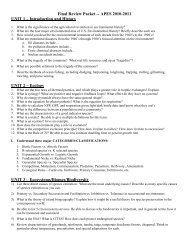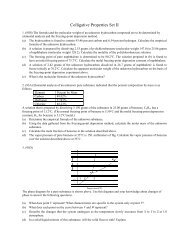Formulas to memorize: Percent error = | literature value â measured ...
Formulas to memorize: Percent error = | literature value â measured ...
Formulas to memorize: Percent error = | literature value â measured ...
Create successful ePaper yourself
Turn your PDF publications into a flip-book with our unique Google optimized e-Paper software.
<strong>Formulas</strong> <strong>to</strong> <strong>memorize</strong>:<br />
<strong>Percent</strong> <strong>error</strong> = | <strong>literature</strong> <strong>value</strong> – <strong>measured</strong> <strong>value</strong> | x 100 =<br />
Literature <strong>value</strong><br />
D = m/v<br />
Unit 1 Objectives:<br />
• Be able <strong>to</strong> name the correct unit for common chemistry measurements (i.e., length = meter, mass = gram, temp = K)<br />
• Distinguish between precision and accuracy<br />
• Be able <strong>to</strong> count significant figures and use them accurately in math problems<br />
• Be able <strong>to</strong> calculate percent <strong>error</strong> from lab data.<br />
• Be able <strong>to</strong> visually identify and correctly use lab equipment and safety equipment.<br />
• Be able <strong>to</strong> distinguish between qualitative and quantitative descriptions<br />
Practice Questions:<br />
1. The following are descriptions of our classroom. Choose the one that is a quantitative description:<br />
A. 20 meters wide B. white walls C. large D. full of students ___2. Energy in a car<br />
2. Is a measure of the average kinetic energy of the particles making up a substance:<br />
A. velocity B. temperature C. mass D. density<br />
3. When measuring in lab, your readings should have ___ estimated digits:<br />
A. 1 B. 2 C. 3 D. it depends on the equipment<br />
4. In lab, Cathy measures a container that has an actual mass of 25.23 g, she records masses of 32.25 and 31.98 g.<br />
Her results are:<br />
A. accurate B. precise C. precise & accurate D. neither precise nor accurate<br />
5. The symbol for lead is: Pb<br />
6. The name for the element Na is: sodium<br />
7. The balances in lab measure: mass<br />
8. In lab you need <strong>to</strong> accurately measure out 5.2 ml of water, you would use a(n)_graduated cylinder__ for the best<br />
results.<br />
9. How many significant digits in the following numbers? (2 each)<br />
A. 100 _____1_____ B. 0.020010 ____5_______ C. 3100. ____4________<br />
10. Perform the following calculations with your calcula<strong>to</strong>r. Put your answers in the correct number of significant<br />
figures and include the proper units.<br />
A. 7.4 mm x 8.902 mm = 66<br />
B. 8.765 g + 14.0 g = 22.8<br />
C. 97 ml + 14.402 ml = 111<br />
D. 9.84 g / 34 ml = 0.29<br />
11. A student measures the density of cork and finds it <strong>to</strong> be 0.32 g/cm 3 . The actual density is 0.24 g/cm 3 . What is<br />
her percent <strong>error</strong>? 33%<br />
12. Convert 135 g <strong>to</strong> oz (1 oz = 28.35 g) 4.76<br />
13. Convert 4.2 gallons <strong>to</strong> L. (1 gal = 3.8 L) 16<br />
14. Convert 53,000,000 mm 2 <strong>to</strong> m 2 . 53<br />
15. Convert 346 cm <strong>to</strong> feet. 11.4<br />
16. Convert 45 miles/hr <strong>to</strong> cm/sec. 2.0x10 3<br />
Unit 2 Objectives:<br />
• Be able <strong>to</strong> use the density formula <strong>to</strong> solve for any of the variables.<br />
• Distinguish between endothermic and exothermic reactions, physical and chemical changes, physical and<br />
chemical properties, and extensive and intensive properties<br />
• Name the three indica<strong>to</strong>rs that a chemical change has occurred<br />
• Distinguish between elements, compounds, heterogeneous and homogenous solutions<br />
• Recognize organic compounds<br />
1. m = 42 g v = 30.0 cm 3 What is the density (in g/cm 3 )? 1.4 g/cm 3<br />
2. D = 0.823 g/cm 3 m = 4.2 kg What is the volume (in cm 3 )? 4200g/.823 cm 3 = 5100 g/cm 3
For each of the following, indicate if the phrase refers <strong>to</strong> an exothermic or endothermic reaction.<br />
4. releases energy exo-<br />
5. absorbs energy endo-<br />
6. products have more potential energy than reactants endo-<br />
7. products have less potential energy than reactants exo-<br />
8. feels hot <strong>to</strong> the <strong>to</strong>uch exo-<br />
9. feels cool <strong>to</strong> the <strong>to</strong>uch endo-<br />
Classify the following as chemical or physical changes:<br />
10. burning coal C<br />
11. tearing paper P<br />
12. exploding TNT C<br />
Classify the following as physical or chemical properties:<br />
15. density P<br />
16. melting point P<br />
Classify the following as extrinsic or intrinsic properties:<br />
19. mass ex<br />
20. color in<br />
21. ductility in<br />
13. dissolving sugar P<br />
14. digesting food C<br />
17. length P<br />
18. flammability C<br />
22. length Ex<br />
23. melting point In<br />
24. Name three indica<strong>to</strong>rs that a chemical change has occurred. Color change, temp. change, appearance of a<br />
new substance<br />
Classify the following as elements or compounds<br />
25. calcium element<br />
26. water compound<br />
27. sugar compound<br />
28. aluminum element<br />
Classify the following as organic or inorganic compounds:<br />
29. C 6 H 12 O 6 30. H 2 O 31. HCl 32. C 2 H 5 O 2 N<br />
org inorg inorg org
Unit 3 Objectives:<br />
• Describe the 4 major his<strong>to</strong>rical a<strong>to</strong>mic models.<br />
• Explain the experiments or discoveries made by certain scientists<br />
• Relate the experimental results <strong>to</strong> the conclusions made by those scientists<br />
• Write electron configurations for elements<br />
• Use the periodic table <strong>to</strong> predict <strong>value</strong>s for the 4 quantum numbers<br />
• Relate frequency, wavelength, and energy mathematically<br />
• Calculate average a<strong>to</strong>mic mass for a sample of iso<strong>to</strong>pes<br />
• Relate a<strong>to</strong>mic structure <strong>to</strong> a<strong>to</strong>mic/ionic properties (charge, mass)<br />
Match the name of the person with the accomplishment. You may use each name once, more than once, or not at<br />
all.<br />
1. Discovered electrons B<br />
2. First <strong>to</strong> proposed the idea that all matter is made<br />
of a<strong>to</strong>ms. E<br />
3. Discovered the neutron. G<br />
4. Said that the nucleus is solid, but the a<strong>to</strong>m is<br />
mostly space A<br />
5. Found the exact charge of an electron. C<br />
6. Found the mass <strong>to</strong> charge ratio of an electron B<br />
7. Introduced the modern a<strong>to</strong>mic theory D<br />
8. Proposed the planetary (solar system) model of<br />
the a<strong>to</strong>m F<br />
9. Proposed the plum pudding/chocolate chip<br />
model of an a<strong>to</strong>m B<br />
10. proposed the billiard ball model of an a<strong>to</strong>m E/D<br />
A. Rutherford<br />
B. J.J. Thompson<br />
C. Millikan<br />
D. Dal<strong>to</strong>n<br />
E. Democritus<br />
F. Bohr<br />
G. Chadwick<br />
True or false?<br />
11. Electrons and neutrons have similar masses. F<br />
12. A<strong>to</strong>ms (by definition) are always neutral. T<br />
13. An ion is a charged a<strong>to</strong>m. T<br />
14. The number of neutrons in an a<strong>to</strong>m is equal <strong>to</strong> the number of pro<strong>to</strong>ns. F<br />
15. Rutherford used a radioactive substance as his source of particles for his gold foil experiment. T<br />
16. In Rutherford’s experiment, the alpha particles were negatively charged. F<br />
17. If wave A has a larger wavelength than wave B, it should also have a greater frequency. F<br />
18. The set of wavelengths absorbed or emitted by an element is its spectrum. T<br />
19. Black light is composed of all the colors of the rainbow. F (black is the absence of colors)<br />
20. Democritus’ beliefs about the nature of matter were well accepted at the time. F<br />
21. If an ion contains 2 more pro<strong>to</strong>ns than electrons, it will have a +2 charge. T<br />
Complete the following chart. You will need <strong>to</strong> use the periodic table.<br />
Element (use A<strong>to</strong>mic mass A<strong>to</strong>mic number Pro<strong>to</strong>ns Electrons Neutrons<br />
iso<strong>to</strong>pic notation)<br />
13 C +4 13 6 6 2 7<br />
23 Na 23 11 11 11 12<br />
35 Cl -2 35 17 17 19 18<br />
108 Ag +2 108 47 47 45 61<br />
22. When an a<strong>to</strong>m absorbs energy, what happens <strong>to</strong> the electrons (where do they move)? Away from the nucleus<br />
23. A. Describe Rutherford’s gold foil experiment. What evidence led him <strong>to</strong> conclude:<br />
a. the a<strong>to</strong>m is mostly empty space. Most alphas passed through undeflected
. The a<strong>to</strong>m has a positively charged nucleus. Some alphas deflected and some severely<br />
24. List two ways an electron is different from a pro<strong>to</strong>n. Mass, spin, charge, composition, electrons not subject <strong>to</strong><br />
the strong nuclear force.<br />
Calculations: Show all work and circle your final answer. Don’t forget <strong>to</strong> put units on your final answer.<br />
25. Find the average a<strong>to</strong>mic mass of a fictitious element, X, if 89.6% of its a<strong>to</strong>ms have an a<strong>to</strong>mic mass of 124.988 u<br />
and 10.4% have an a<strong>to</strong>mic mass of 123.958 u. 124.881 u<br />
26. What is the frequency of a wave that has a wavelength of 4.24 x 10 -9 m? 7.08 x 10 -16 Hz<br />
27. How much energy is contained in a form of electromagnetic energy with a frequency of 3.62 x 10 -5 Hz?<br />
2.39x10 -38 J<br />
a. When an a<strong>to</strong>m jumps down from the 3 nd energy level back <strong>to</strong> the 1 st , it releases 4.4 x 10 -19 joules of energy.<br />
What is the frequency of light emitted? f = 6.6 x 10 14 Hz<br />
b.What is the wavelength associated with this frequency? 4.5 x 10 -7 m<br />
c. What color is the light (refer <strong>to</strong> the chart in your course packet)?<br />
Visible light (these are approximate)<br />
Violet – 4.0 x 10 -7 – 4.2 x 10 -7 m<br />
Indigo/Blue – 4.2 x 10 -7 – 4.6 x 10 -7 m<br />
Green – 4.6 x 10 -7 – 5.0 x 10 -7 m<br />
Yellow – 5.0 x 10 -7 – 5.8 x 10 -7 m<br />
Orange – 5.8 x 10 -7 – 6.3 x 10 -7 m<br />
Red – 6.3 x 10 -7 – 7.0 x 10 -7 m<br />
28. The pho<strong>to</strong>electric effect describes the emission of electrons from certain metals when they are radiated by a<br />
light source. The minimum energy needed <strong>to</strong> remove an electron from the metal is called the work function and<br />
is a characteristic of the metal. For example, chromium (Cr) metal will emit electrons when the wavelength of<br />
the radiation is 284 nm or less. Calculate the work function for chromium. (284 nm = 2.84 x 10 -7 m). Hint:<br />
This is a 2-part question! W = 7.00 x 10 -19 J<br />
29. What does each of the four quantum numbers designate (n, l, m, and s)? n = energy level, l = sublevel, m =<br />
orbital, s = spin up/down<br />
30. State Heisenberg’s uncertainty principle. You cannot know exactly position and momentum of a particle<br />
simultaneously.<br />
31. State Pauli’s exclusion principle. No two electrons in an a<strong>to</strong>m can have the same 4 quantum number <strong>value</strong>s.<br />
32. Two electrons in the same orbital with different spins are said <strong>to</strong> be _degenerate (equal in energy)_.<br />
33. What was de Broglie’s contribution <strong>to</strong> chemistry? Proposed that matter can have wave-like properties.<br />
34. Who developed the wave-mechanical model of the a<strong>to</strong>m? Erwin Schrodinger<br />
35. Draw the orbital diagrams for the following elements (try this online utility!):<br />
a. Rh (skip) b. Br c. Li d. O<br />
36. Give the symbols for the following elements:<br />
a. 1s 2 2s 2 2p 6 3s 2 3p 6 4s 2 3d 3 V<br />
b. 1s 2 2s 2 Be<br />
c. 1s 2 2s 2 2p 4 O<br />
d. 1s 2 2s 2 2p 6 3s 2 3p 6 4s 2 3d 10 4p 6 5s 2 4d 10 5p 6 6s 2 4f 14 5d 8 Pt
37. How many electrons can be held in a single orbital? 2<br />
38. How many orbitals are in an s sublevel? 1 p sublevel? 3 d sublevel? 5 f sublevel? 7<br />
39. What is the oxidation state (charge) for the following elements?<br />
e. S -2 b. F -1 c. Ge +4 d. Be +2 e. Rb +1<br />
40. Look at the periodic table. Name one metal. _______________ Name one non-metal. _____________. Name<br />
one metalloid. ___________________. Name one transition metal. ______________________. Name one<br />
noble gas. __________________. (For the test, be able <strong>to</strong> identify where each is located on the periodic table).<br />
Unit 4 Objectives:<br />
• List the seven dia<strong>to</strong>mic molecules.<br />
• Know the formulas and charges of the 9 polya<strong>to</strong>mic ions on your homework sheet.<br />
• Know the formulas and names of the 7 acids on you homework sheet.<br />
• Know the difference between a cation and an anion.<br />
• Determine the number of valence electrons in an element<br />
• Draw Lewis structures for elements, molecules (covalent compounds), and ionic compounds<br />
• Use electronegativity differences <strong>to</strong> predict whether a bond will be ionic or covalent.<br />
• Describe how a spectropho<strong>to</strong>meter works<br />
o Describe how <strong>to</strong> prepare and use a standard curve<br />
o Give common <strong>error</strong> sources for spectropho<strong>to</strong>metric measurements<br />
1. Write the formulas for the 7 dia<strong>to</strong>mic molecules. H 2 , N 2 , O 2 , F 2 , Cl 2 , I 2 , Br 2<br />
2. Name the following:<br />
a. NH +1 4 __________________<br />
b. HCO -1 3 _________________<br />
c. NO -1 3 __________________<br />
d. SO -2 4 __________________<br />
e. HCl ______________________<br />
f. HI _______________________<br />
g. HNO 3 ______________________<br />
h. CH 3 COOH ____________________<br />
i. HSO - 4 ____________________<br />
3. Write the formulas for the following:<br />
a. Acetate ________________________<br />
b. Hydroxide ______________________<br />
c. Carbonate _______________________<br />
d. Phosphate _________________________<br />
e. Hydrobromic acid ______________<br />
f. Sulfuric acid __________________<br />
g. Perchloric acid ________________<br />
4. Propose Lewis Structures for the following compounds:<br />
a b c d<br />
O<br />
N<br />
O -1<br />
O<br />
H<br />
H<br />
S: H P :<br />
H B<br />
O<br />
O<br />
H<br />
H<br />
5. Answer these questions about spectropho<strong>to</strong>metry<br />
a. Fingerprints or smudges can scatter light, causing the absorbance <strong>to</strong> be read incorrectly.<br />
b. The purpose of the blank is <strong>to</strong> remove the absorbances of other compounds you aren’t interested in from<br />
the absorbance spectrum for the solution, leaving only your species of interest. In other words, it sets the<br />
absorbance <strong>to</strong> 0 for a solution that doesn’t contain your unknown.<br />
c. About .55 (draw over from the Y axis <strong>to</strong> the line, then drop down <strong>to</strong> the X).


